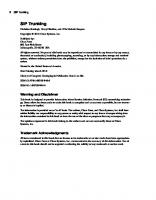Sip: Understanding the Session Initiation Protocol [1 ed.] 1580531687, 9781580531689, 9781580534130
Beginning with a short summary of the core protocols and addressing of the Internet and the World Wide Web, this introdu
162 97 34KB
English Pages 228 [225] Year 2001
Table of contents :
Contents......Page 8
1.1 Signaling Protocols......Page 24
1.2 The Internet Engineering Task Force......Page 25
1.4 Internet Multimedia Protocol Stack......Page 26
1.4.2 Internet Layer......Page 27
1.4.3 Transport Layer......Page 28
1.5 Utility Applications......Page 30
1.6 DNS and IP Addresses......Page 31
1.8 Multicast......Page 33
1.9 ABNF Representation......Page 34
References......Page 35
2.1 A Simple SIP Example......Page 38
2.2 SIP Call with Proxy Server......Page 46
2.3 SIP Registration Example......Page 51
2.4.1 UDP Transport......Page 53
2.4.2 TCP Transport......Page 54
References......Page 56
3.1 SIP User Agents......Page 58
3.2 SIP Gateways......Page 59
3.3.1 Proxy Servers......Page 62
3.3.2 Redirect Servers......Page 65
3.4 Acknowledgment of Messages......Page 68
3.5 Reliability......Page 69
3.6 Authentication......Page 70
3.7 Encryption......Page 71
3.9 Firewalls and NAT Interaction......Page 73
References......Page 75
4.1 Methods......Page 76
4.1.1 INVITE......Page 77
4.1.2 REGISTER......Page 80
4.1.3 BYE......Page 81
4.1.4 ACK......Page 83
4.1.5 CANCEL......Page 86
4.1.6 OPTIONS......Page 88
4.1.7 INFO......Page 89
4.1.8 PRACK......Page 91
4.2 SIP URLs and URIs......Page 93
4.3 Tags......Page 95
4.4 Message Bodies......Page 96
References......Page 97
5 SIP Response Messages......Page 98
5.1 Informational......Page 99
5.1.3 181 Call Is Being Forwarded......Page 100
5.1.5 183 Session Progress......Page 101
5.2 Success 200 OK......Page 102
5.3 Redirection......Page 103
5.3.4 305 Use Proxy......Page 104
5.4.2 401 Unauthorized......Page 105
5.4.6 405 Method Not Allowed......Page 106
5.4.10 409 Conflict......Page 107
5.4.16 420 Bad Extension......Page 108
5.4.20 482 Loop Detected......Page 109
5.4.22 484 Address Incomplete......Page 110
5.4.23 485 Ambiguous......Page 111
5.5 Server Error......Page 112
5.5.6 505 Version Not Supported......Page 113
5.6.4 606 Not Acceptable......Page 114
References......Page 115
6.1 General Headers......Page 116
6.1.1 Call- ID......Page 117
6.1.2 Contact......Page 118
6.1.3 CSeq......Page 119
6.1.5 Encryption......Page 121
6.1.7 Organization......Page 122
6.1.9 Subject......Page 123
6.1.12 To......Page 124
6.1.14 Via......Page 125
6.2.1 Accept......Page 127
6.2.2 Accept- Contact......Page 128
6.2.4 Accept- Language......Page 129
6.2.6 Hide......Page 130
6.2.9 Priority......Page 131
6.2.10 Proxy- Authorization......Page 132
6.2.12 Record- Route......Page 133
6.2.15 Require......Page 134
6.2.19 Session- Expires......Page 135
6.3.3 Unsupported......Page 136
6.3.5 WWW- Authenticate......Page 137
6.4 Entity Headers......Page 139
6.4.4 Content- Length......Page 140
6.4.6 Expires......Page 141
References......Page 142
7.1 SDPÛSession Description Protocol......Page 144
7.1.5 E- mail Address and Phone Number......Page 147
7.1.8 Time, Repeat Times, and Time Zones......Page 148
7.1.10 Media Announcements......Page 149
7.1.12 Use of SDP in SIP......Page 150
7.2 RTPÛReal- time Transport Protocol......Page 153
7.3 RTP Audio Video Profiles......Page 156
7.4.3 ISDN Signaling......Page 158
References......Page 159
8.1 Introduction to H. 323......Page 160
8.2 Example of H. 323......Page 162
8.4 Comparison......Page 167
8.4.1 Encoding......Page 168
8.4.2 Transport......Page 170
8.4.4 Complexity......Page 171
8.4.7 Conferencing......Page 172
8.4.8 Extensibility......Page 173
References......Page 174
9.1 SIP Call with Authentication, Proxies, and Record- Route......Page 176
9.2 SIP Call with Stateless and Stateful Proxies with Called Party Busy......Page 184
9.3 SIP to PSTN Call Through Gateway......Page 187
9.4 PSTN to SIP Call Through Gateway......Page 192
9.5 Parallel Search......Page 195
9.6 H. 323 to SIP Call......Page 200
References......Page 206
10.1 Changes to RFC 2543......Page 208
10.2 SIP Working Group Design Teams......Page 209
10.2.1 Call Control......Page 210
10.2.6 SIP Security......Page 211
References......Page 212
About the Author......Page 214
Index......Page 216
Contents......Page 8
1.1 Signaling Protocols......Page 24
1.2 The Internet Engineering Task Force......Page 25
1.4 Internet Multimedia Protocol Stack......Page 26
1.4.2 Internet Layer......Page 27
1.4.3 Transport Layer......Page 28
1.5 Utility Applications......Page 30
1.6 DNS and IP Addresses......Page 31
1.8 Multicast......Page 33
1.9 ABNF Representation......Page 34
References......Page 35
2.1 A Simple SIP Example......Page 38
2.2 SIP Call with Proxy Server......Page 46
2.3 SIP Registration Example......Page 51
2.4.1 UDP Transport......Page 53
2.4.2 TCP Transport......Page 54
References......Page 56
3.1 SIP User Agents......Page 58
3.2 SIP Gateways......Page 59
3.3.1 Proxy Servers......Page 62
3.3.2 Redirect Servers......Page 65
3.4 Acknowledgment of Messages......Page 68
3.5 Reliability......Page 69
3.6 Authentication......Page 70
3.7 Encryption......Page 71
3.9 Firewalls and NAT Interaction......Page 73
References......Page 75
4.1 Methods......Page 76
4.1.1 INVITE......Page 77
4.1.2 REGISTER......Page 80
4.1.3 BYE......Page 81
4.1.4 ACK......Page 83
4.1.5 CANCEL......Page 86
4.1.6 OPTIONS......Page 88
4.1.7 INFO......Page 89
4.1.8 PRACK......Page 91
4.2 SIP URLs and URIs......Page 93
4.3 Tags......Page 95
4.4 Message Bodies......Page 96
References......Page 97
5 SIP Response Messages......Page 98
5.1 Informational......Page 99
5.1.3 181 Call Is Being Forwarded......Page 100
5.1.5 183 Session Progress......Page 101
5.2 Success 200 OK......Page 102
5.3 Redirection......Page 103
5.3.4 305 Use Proxy......Page 104
5.4.2 401 Unauthorized......Page 105
5.4.6 405 Method Not Allowed......Page 106
5.4.10 409 Conflict......Page 107
5.4.16 420 Bad Extension......Page 108
5.4.20 482 Loop Detected......Page 109
5.4.22 484 Address Incomplete......Page 110
5.4.23 485 Ambiguous......Page 111
5.5 Server Error......Page 112
5.5.6 505 Version Not Supported......Page 113
5.6.4 606 Not Acceptable......Page 114
References......Page 115
6.1 General Headers......Page 116
6.1.1 Call- ID......Page 117
6.1.2 Contact......Page 118
6.1.3 CSeq......Page 119
6.1.5 Encryption......Page 121
6.1.7 Organization......Page 122
6.1.9 Subject......Page 123
6.1.12 To......Page 124
6.1.14 Via......Page 125
6.2.1 Accept......Page 127
6.2.2 Accept- Contact......Page 128
6.2.4 Accept- Language......Page 129
6.2.6 Hide......Page 130
6.2.9 Priority......Page 131
6.2.10 Proxy- Authorization......Page 132
6.2.12 Record- Route......Page 133
6.2.15 Require......Page 134
6.2.19 Session- Expires......Page 135
6.3.3 Unsupported......Page 136
6.3.5 WWW- Authenticate......Page 137
6.4 Entity Headers......Page 139
6.4.4 Content- Length......Page 140
6.4.6 Expires......Page 141
References......Page 142
7.1 SDPÛSession Description Protocol......Page 144
7.1.5 E- mail Address and Phone Number......Page 147
7.1.8 Time, Repeat Times, and Time Zones......Page 148
7.1.10 Media Announcements......Page 149
7.1.12 Use of SDP in SIP......Page 150
7.2 RTPÛReal- time Transport Protocol......Page 153
7.3 RTP Audio Video Profiles......Page 156
7.4.3 ISDN Signaling......Page 158
References......Page 159
8.1 Introduction to H. 323......Page 160
8.2 Example of H. 323......Page 162
8.4 Comparison......Page 167
8.4.1 Encoding......Page 168
8.4.2 Transport......Page 170
8.4.4 Complexity......Page 171
8.4.7 Conferencing......Page 172
8.4.8 Extensibility......Page 173
References......Page 174
9.1 SIP Call with Authentication, Proxies, and Record- Route......Page 176
9.2 SIP Call with Stateless and Stateful Proxies with Called Party Busy......Page 184
9.3 SIP to PSTN Call Through Gateway......Page 187
9.4 PSTN to SIP Call Through Gateway......Page 192
9.5 Parallel Search......Page 195
9.6 H. 323 to SIP Call......Page 200
References......Page 206
10.1 Changes to RFC 2543......Page 208
10.2 SIP Working Group Design Teams......Page 209
10.2.1 Call Control......Page 210
10.2.6 SIP Security......Page 211
References......Page 212
About the Author......Page 214
Index......Page 216
![Sip: Understanding the Session Initiation Protocol [1 ed.]
1580531687, 9781580531689, 9781580534130](https://ebin.pub/img/200x200/sip-understanding-the-session-initiation-protocol-1nbsped-1580531687-9781580531689-9781580534130.jpg)
![SIP: Understanding the Session Initiation Protocol [2 ed.]
9781580536554, 1580536557](https://ebin.pub/img/200x200/sip-understanding-the-session-initiation-protocol-2nbsped-9781580536554-1580536557.jpg)




![SIP Demystified [1 ed.]](https://ebin.pub/img/200x200/sip-demystified-1nbsped.jpg)



![SIP Security [1 ed.]
0470516364, 9780470516362](https://ebin.pub/img/200x200/sip-security-1nbsped-0470516364-9780470516362.jpg)